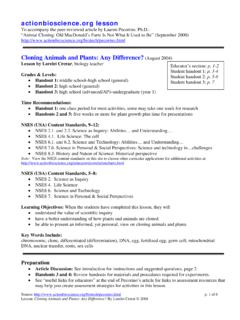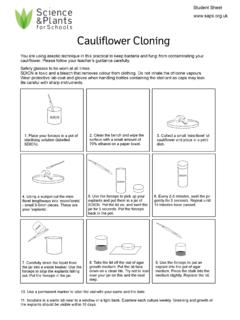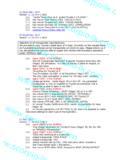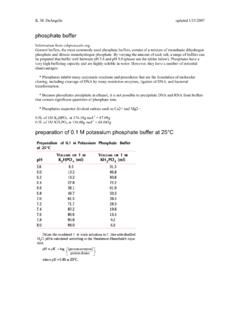Transcription of In-Fusion® HD Cloning Kit User Manual - takara.co.kr
1 In- fusion HD Cloning KitUser ManualPT5162-1 (PR133833)April 2011 United Pacific+ +33.(0) +81.(0) Laboratories, Takara Bio Company1290 Terra Bella View, CA 94043 Technical Support (US)E-mail: ManualIn- fusion HD Cloning Kit user ManualProtocol No. PT5162-1 Clontech Laboratories, Inc. Version No. PR133833 A Takara Bio Company2 Table of ContentsI. Introduction ..3II. List of Components ..5 III. Additional Materials Required ..5IV. PCR and Experimental Preparation ..6V. Which Protocol Should You Follow? ..9VI. Protocol I: In- fusion Cloning Procedure w/Spin-Column Purification ..9 VII. Protocol II: In- fusion Cloning Procedure w/ Cloning Enhancer Treatment .. Procedure ..11IX.
2 Expected Results ..11X. Troubleshooting Guide ..12XI. Appendix A: Quick In- fusion Cloning Protocol ..14 XII. Appendix B: pUC19 Linearized Vector Information ..15 Contact Us For AssistanceCustomer Service/Ordering:Technical Support:Telephone: (toll-free)Telephone: (toll-free)Fax: (toll-free)Fax: : : : Clontech Laboratories, Inc. Protocol No. PT5162-1A Takara Bio Company Version No. PR1338333In- fusion HD Cloning Kit user ManualI. IntroductionIn- fusion HD Cloning Kits are designed for fast, directional Cloning of one or more fragments of DNA into any vector. The cornerstone of In- fusion Cloning technology is Clontech s proprietary In- fusion Enzyme, which fuses DNA fragments PCR-generated sequences and linearized vectors, efficiently and precisely by recognizing a 15 bp overlap at their ends.
3 This 15 bp overlap can be engineered by designing primers for amplification of the desired sequences. In- fusion HD Kits offer increased Cloning efficiency over previous generations of In- fusion Kits, especially for longer fragments, short oligonucleotides, and multiple fragments. Clone any insert, into any location, within any vector you choose Efficiently clone a broad range of fragment sizes Clone multiple DNA fragments simultaneously into any vector in a single reaction! No restriction digestion, phosphatase treatment, or ligation required Final constructs are seamless with no extra or unwanted base pairs The table below is a general outline of the protocol used for the In- fusion HD Cloning Kits.
4 This outline is further illustrated in Figure 1. Please refer to the specified pages for details on performing each step. Table I. In- fusion HD Protocol OutlineStepActionPages1 Select a base vector and identify the insertion site. Linearize the vector by restriction enzyme digestion or inverse PCR and purify. 62 Design PCR primers for your gene of interest with 15 bp extensions (5 ) that are complementary to the ends of the linearized your gene of interest with a high-fidelity DNA polymerase. Verify on an agarose gel that your target DNA has been amplified and determine the integrity of the PCR purify your PCR product OR treat it with Cloning Enhancer. Spin-Column Protocol I ( ) ORCloning Enhancer Protocol II ( )5 Set up your In- fusion Cloning reaction:2 l of 5X In- fusion HD Enzyme Premix X l of Linearized Vector X l of Insert X l of dH20 to a Total Reaction Volume of 10 l.
5 Mix well. Spin-Column Protocol I ( ) ORCloning Enhancer Protocol II ( )6 Incubate the reaction for 15 min at 50 C, then place on ice. Spin-Column Protocol I ( )ORCloning Enhancer Protocol II ( ) 7 Transform competent cells with l of the reaction mixture from Step 6. 11In- fusion HD Cloning Kit user ManualProtocol No. PT5162-1 Clontech Laboratories, Inc. Version No. PR133833 A Takara Bio Company4 Figure 1. In- fusion HD Protocol Introduction, continued2 l 5X In- fusion Enzyme Premixx l Linearized Vectorx l Insertx l dH2O10 l Total VolumeSet up the In- fusion Cloning reactionStep 5 Amplify your gene of interestStep 3 Add 2 l of Cloning Enhancer to 5 l of PCR productand incubate 15 min at 37 C, 15 min at 80 CStep 4 Incubate Cloning reactionStep 615 min at 50 C15 bp15 bpPCR product*Tr ansform competent E.
6 Coli with the reaction mixtureStep 7 Generate a linearized vectorStep 1 Design gene-specific primers with 15 bp extensions complementary to vector endsStep 2 ORSpin-column purifyStep 4 Screen clonesx xNew construct*If you obtain PCR product with non-specific background, isolate the target fragment by gel extraction first, then spin-column purify. Clontech Laboratories, Inc. Protocol No. PT5162-1A Takara Bio Company Version No. PR1338335In- fusion HD Cloning Kit user ManualII. List of ComponentsIn- fusion HD Cloning KitsComponentsCat. Nos. rxns50 rxns100 rxns5X In- fusion HD Enzyme Premix20 l100 l200 lpUC19 Control Vector, linearized (50 ng/ l)5 l15 l30 l2 kb Control Insert (40 ng/ l)10 l30 l60 lIn- fusion HD Cloning Kits are available in 10, 50 and 100 reaction sizes.
7 Kits can also be purchased with Stellar Competent Cells, NucleoSpin Extract II, and/or Cloning Enhancer. Store all components at 20 Additional Materials RequiredThe following materials are required but not supplied:Ampicillin (100 mg/ml stock) or other antibiotic required for plating the In- fusion reactionLB (Luria-Bertani) medium (pH ) LB/antibiotic plates SOC medium Competent Cells We recommend the use of Stellar Competent Cells. If you decide to use other commercially-available competent cells ( , DH10B, DH5 ), make sure that they have a transformation efficiency x 108 cfu/ g. Many In- fusion HD Cloning Kits come with Stellar Competent Cells, but you can also purchase the cells separately in various Enhancer (Cat.)
8 Nos. 639613, 639614 & 639615) [Optional] Cloning Enhancer is provided with some of the In- fusion HD Cloning Kits and can also be purchased sepa-rately. Cloning Enhancer removes background template DNA and PCR residue, eliminating the need for PCR insert purification prior to Cloning when a single PCR product ( , no background) is Columns NucleoSpin Extract II (Cat. Nos. , & ) [Optional]NucleoSpin Extract II is provided with some of the In- fusion HD Cloning Kits and can also be purchased separately. Spin columns can be used to purify PCR products, if non-specific background or multiple bands are visible on an agarose gel. When spin columns are needed, we recommend NucleoSpin Ex-tract II.
9 NucleoSpin Extract II is provided with some of the In- fusion HD Cloning Kits and can also be purchased separately. In- fusion HD Cloning Kit user ManualProtocol No. PT5162-1 Clontech Laboratories, Inc. Version No. PR133833 A Takara Bio Company6IV. PCR and Experimental PreparationA. Preparation of a Linearized Vector by Restriction DigestionTo achieve a successful In- fusion reaction, you must first generate a linearized vector. The linearized vector can be generated using restriction enzymes (single or double digests) or by PCR. Due to differences in cutting efficiencies, different restriction enzymes will generate different amounts of background. Generally speaking, two enzymes cut better than any single enzyme.
10 Efficiency of digestion will always be better if the restriction sites are as far apart as possible. In addition, increasing the enzyme digestion time and the digestion reaction volume will reduce the background. Recommendations for preparation of a linearized vector by restriction enzyme digestion:Incubate your restriction digest as directed by the restriction enzyme supplier. For many enzymes, 1. incubation from 3 hours to overnight can increase linearization and reduce digestion, purify the linearized vector using any available PCR purification kit. We recommend gel 2. purification using the NucleoSpin Extract II Kit. [Control]3. Check the background of your vector by transforming 5 10 ng of the linearized and purified vector into competent the background is high, continue digesting the vector for a longer time after the addition of more restric-tion enzyme(s).






